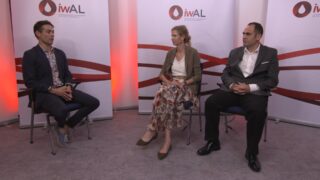Yes, so I gave an overview on CAR hematotoxicity post CAR T-cells, which actually has the highest cumulative incidence of higher grade immune-related adverse events after CAR T-cell therapy, more common than CRS and ICANS, and has been shown that this occurs independent of CAR T-cell product in all disease entities, also in CAR T-cells directed against CD19 as well as BCMA. And the special thing about hematotoxicity post-CAR T-cells is that there are three different neutrophil recovery types...
Yes, so I gave an overview on CAR hematotoxicity post CAR T-cells, which actually has the highest cumulative incidence of higher grade immune-related adverse events after CAR T-cell therapy, more common than CRS and ICANS, and has been shown that this occurs independent of CAR T-cell product in all disease entities, also in CAR T-cells directed against CD19 as well as BCMA. And the special thing about hematotoxicity post-CAR T-cells is that there are three different neutrophil recovery types. So there’s a quick recovery, like you would expect after the full depletion. There’s this biphasic, with a drop of the neutrophil counts post day 21. And then there’s this aplastic, with a long-term neutropenia beyond day 14. I think the current CTCAE criteria don’t match the profile of neutrophil recovery. Just as a reminder, in the CTCAE criteria we have a cutoff of 1500, 1000 plus minus 500 for grades 3 and 4, but it does not integrate also the length of neutropenia. So a new EBMT, EHA-based classification was developed to classify CAR hematotoxicity. It integrates lengths and depths of neutropenia and we differentiate in early hematotoxicity under day 30 and late hematotoxicity, post day 30. And as I said, it has cut-offs for 500, below 100 neutrophils and also the length of neutropenia. And if you apply this, and that was shown at ASH by Kai Rejewski, still hematotoxicity is the most common immune-related adverse event. And why is this important? If you also look at immune reconstitution, you can see that post-CAR T-cells, you have long-term CD4 lymphopenia, you have long-term B-cell aplasia, which is actually, interestingly, quite different between CD28 and 41BB construct. Both of these factors contribute to non-relapse mortality and has been shown in a big meta-analysis that the most common cause of non-relapse mortality across disease entities using commercial CAR T-cell products is 7 percent. The cause of this are infection about half of the patient. And when you look in more detail what kind of infections are actually occurring, you can see and I must have to say that only one-third of the reports that were analyzed for this meta-analysis actually reported on the cause of infectious complications and here COVID clearly contributed about half of these. And there has been also a recent report by the French consortium. They reported on non-relapse mortality of 5%. They looked at early and late causes of non-relapse mortality. Two facts we can learn from there. Most of these cases occur post-day 30, and early as well as late non-relapse mortality is again driven by infectious complications. So what can we do about it? I’d like to highlight that there is a CAR hematotox score which integrates parameters prior to lymphodepletion, hemoglobin, neutrophils, platelets, CRP, and ferritin, And you can classify these patients in a low score and in a high score. And I think it would be important that first of all, in the low risk patients, they have a low risk of prolonged cytopenia, they have a low risk of higher grade infections. So probably it would also be feasible to give these patients not broad spectrum antibiotics when they have a fever, also thinking of their microbiome. And in the high-risk patients, I think it’s justified to apply early GCSF, go strong with the antibiotics and the prophylaxis. So on the one hand, decrease side effects of broad-spectrum antibiotics. On the other hand, escalate and protect these patients. And I think the third message is we need to have a good connection, transsectoral connection with physicians that are not working on a CAR T-cell hospital so that they are aware of the high risk profile of our patients post-CAR T-cell for fatal infectious complications. And clearly we need clinical trials to answer some of these questions.
This transcript is AI-generated. While we strive for accuracy, please verify this copy with the video.














